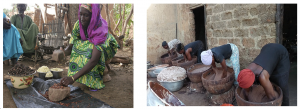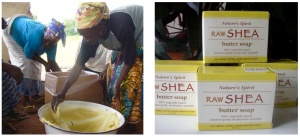Trees, tribe and technology: how the tech-revolution is fostering sustainability along the shea value chain
25th January 2021
This blog piece was written by CCF member and newsletter moderator Linda Amanya, based on a research study on technology and the shea value chain in Uganda. Linda has an MSc. in Tropical Forestry from Bangor University, UK.
Forests play a complex but indispensable role in lifting households out of persistent poverty. South of the Sahara, forest resources have been a lifeline for approximately sixty-five per cent of the population, over the last decade alone. Benefits such as timber, climate regulation, watershed protection and ecotourism have supported local communities and contributed significantly to development on the continent; earning up to 10 per cent of the Gross Domestic Product (GDP) for least 19 African countries. And whereas timber production is the number one use for many high value tree species, exploitation for non-timber forest products (NTFP) such as gum, oils, resins, fruit, medicines and fodder commercially benefits even more individuals. NTFP provide between 29 and 39 percent of the food, medicine and income for a staggering 80% of the population living in forest areas in Central Africa. Products such as the cola nut, bush mangoes, mushrooms, Djansang and shea fruits are not only viewed as sources of supplementary income in forest dependent communities, but also as hunger foods, providing safeguards in times of food scarcity.
The shea tree, scientifically known as Vitellaria paradoxa, supports livelihoods across a 3.41 million km2 belt in sub-Saharan Africa. In terms of oil production, the once ‘under-utilized’ crop presently comes second only to the palm nut tree among valuable oil crops on the continent. Rich in stearic acid, what was once a simple additive for traditional cuisine among the Lango in Northern Uganda and the Waala in Northern Ghana, has transformed into a staple for upscale cosmetic brands like The Body Shop and L’Occitane in Europe, the Americas and Asia. From confectionary use to pharmaceutical application as an anti-inflammatory, the market potential for shea butter is simply endless. A 2020 Global Shea Alliance and FAO project reports shea exports to have increased from 50,000 metric tons (MT) to 300,000 MT, over the last 20 years, providing income for more than 16 million women in Africa.
In Uganda, the shea story begins in Sudano – Sahelian parkland communities, in districts like Lira, Kitgum and Pader. Similar to their counterparts in West Africa, upstream producers (mainly women’s associations) undertake labour – intensive tasks including walking several miles to collect shea fruits from scanty tree populations; roasting the nuts over open fires; de-husking them using mortars and pestles, and kneading/boiling the paste to finally produce the yellow-gold oil.

Wala women de-husking shea nuts and kneading shea paste. Photo credit: Wikipedia commons
Progress has been made in mechanizing operations in a few producer communities, but in areas where traditional techniques and production tools are still utilized, the urge to utilize shea trees for fuel wood instead of butter is tenacious; so much so that bans have been imposed to protect the vulnerable species in Uganda.
New trends and emerging markets have increased dependence on already aging shea tree populations. Additionally, threats such as land-use change, demand for wood fuel and climate change continue to rapidly diminish shea tree populations. Sustainably managing shea resources therefore calls for more innovative approaches. It is this gap that technology attempts to bridge: the gap between utilization and conservation.

Pure and processed shea butter. Photos by Nia Divine and morelifeml on flickr
Producers downstream employ diverse technologies in their operations. With biotechnology and advanced production equipment, these stakeholders are not only facilitating product diversification but also indirectly supporting tree conservation when less quantities of shea butter are utilized in product formulations; they are reducing shea waste with more efficient production tools and averting carbon emission when renewable energy sources or solvent extraction methods are utilized.
Information and communication technology, especially e-marketing has expanded the reach of shea butter, beyond the African continent. While this may have increased pressure on shea trees, export of unrefined butter ensures that it does not go to waste due to underutilization on the continent. Quality control through initiatives like fair trade and eco-certification makes use of product testing technologies, and in addition to providing compensation for best practices, it often supports species’ conservation through commitments to ecological standards and integrity.
Many are the benefits of technology in the shea sector, but equally, many are the pits falls. Appropriate policies and legislations need to be crafted, if only to safeguard against over harvesting of shea fruits, which interferes with natural regeneration of tree populations. Processes should be facilitated to inform stakeholders, under different socio-economic settings, of the opportunities and challenges of the shea sector, beyond local borders.
Shea refining and value addition could be better facilitated upstream through skilling players and supporting producer communities with appropriate technologies. For one, this would reduce the carbon footprint associated with exporting tonnes of unrefined shea butter and shea kernels across the globe. And while significant investment has gone into product innovation and process mechanization, a lot more could be done to ensure that tree populations are increased through research in reproduction technologies.
Today, it may be difficult to imagine how a tree species that once stretched across a continent could be vulnerable to extinction. But for trees that takes 15 to 20 years to start fruiting and are prone to irregular bearing, chiefly relying on natural regeneration – as is the case in most shea producing countries, leaves the sustainability of the shea sector unpredictable.
Banner image: Shea fruits on the Vitellaria paradoxa tree, photo credit Wiki commons
